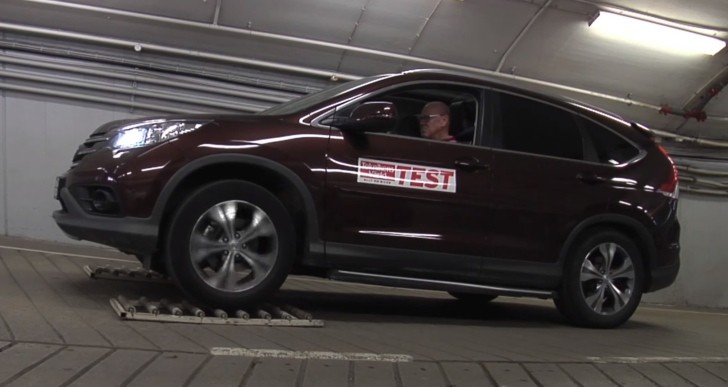With crossovers basically taking over the market, the FWD vs 4WD debate is becoming more and more fiery, as most carmakers offer both possibilities for their models. In a rather surprising move, the European Honda CR-V comes to show that sometimes the all-wheel drive is pure marketing - the vehicle has been tested by Swedish magazine Teknikens Värld, with its 4WD system failing to work properly and basically letting the front axle do 100 percent of the work.
The Swedes, the same people who announced the Porsche Macan failed the moose test, put the CR-V through their usual barrage of procedures for all-wheel drive crossovers and SUV. The car was driven on an incline, with the front wheels over a pair of rollers, which only left the rear wheels on the traction side.
With the 4WD system obviously engaged, the front wheels kept spinning, while no power was sent to the rear whatsoever. As a result, the CR-V not only failed to climb the simulated hill, but started rolling backwards at a certain point.
While Honda explained the bug was actually a feature (they cited a built-in functionality to limit mechanical wear), the carmaker did pay attention to the problem - they offered customers in Sweden a software update that was supposed to fix everything.
Nonetheless, this doesn’t justify the CR-V’s incapacity to actually work as a 4WD vehicle in the given situation. In fact, the Swedish publication also put one of the CR-V’s main competitors, a Ford Kuga, to the test. The Ford obviously had no issue in dealing with the scenario.
With the 4WD system obviously engaged, the front wheels kept spinning, while no power was sent to the rear whatsoever. As a result, the CR-V not only failed to climb the simulated hill, but started rolling backwards at a certain point.
Honda was supposed to have fixed this issue
Some might wonder if this test was approved by Honda and, according to the magazine, the answer is “yes”. That’s because the CR-V was actually re-evaluated after failing a similar test last year.While Honda explained the bug was actually a feature (they cited a built-in functionality to limit mechanical wear), the carmaker did pay attention to the problem - they offered customers in Sweden a software update that was supposed to fix everything.
What now?
The automotive produces obviously won’t ignore this, so we’ll have to wait for its move. Admittedly, this is the typical FWD-based system, which can only send a limited amount of the power to the rear axle. The scheme saves fuel, as well as lowering costs for the carmaker, as the rear diff only has to deal with a limited amount of torque and therefore isn’t very complex.Nonetheless, this doesn’t justify the CR-V’s incapacity to actually work as a 4WD vehicle in the given situation. In fact, the Swedish publication also put one of the CR-V’s main competitors, a Ford Kuga, to the test. The Ford obviously had no issue in dealing with the scenario.


